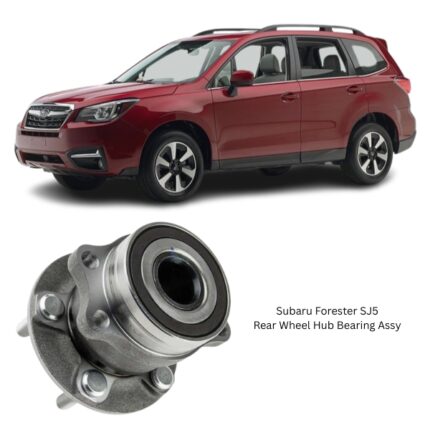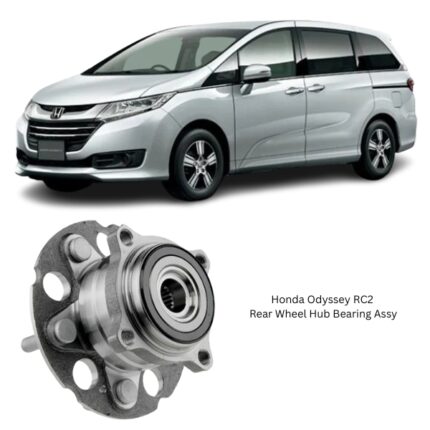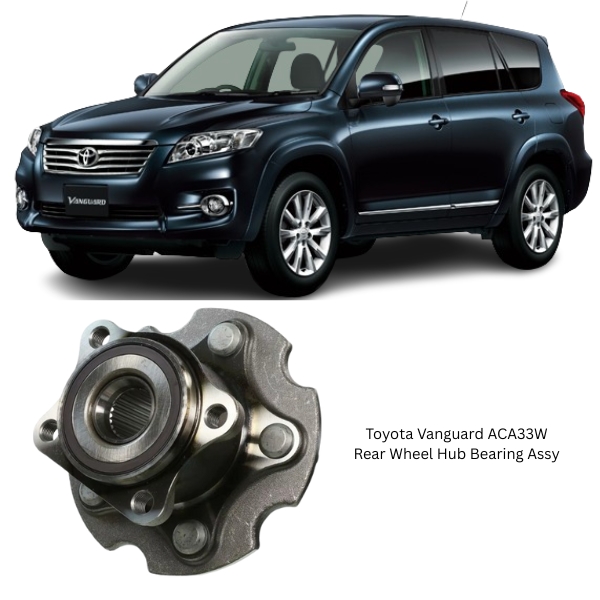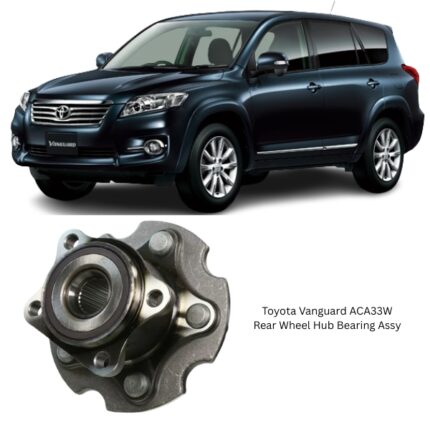Get Toyota Vanguard ACA33W Rear Wheel Hub Bearing Assy 42410-42040 in Kenya
The Rear Wheel Hub Bearing Assembly RH/LH is a crucial mechanical component that integrates two essential functions: the support and rotation of the rear wheel, and the secure connection between the wheel and the vehicle’s suspension. It combines the wheel hub and the wheel bearing into a single, self-contained unit designed to endure high loads, rotational stress, and harsh environmental conditions. Engineered for installation on either the right-hand (RH) or left-hand (LH) side of the rear axle, this assembly plays a foundational role in the functionality, handling, and safety of the vehicle.
Core Functionality
At its core, the rear wheel hub bearing assembly serves as the interface between the wheel and the chassis. It is responsible for:
-
Enabling Wheel Rotation: It houses the wheel bearing, which allows the wheel to rotate smoothly with minimal friction.
-
Supporting Axial and Radial Loads: It must withstand vertical loads from the vehicle’s weight and horizontal forces from turning, acceleration, and braking.
-
Maintaining Alignment: It helps retain the precise positioning of the wheel relative to the suspension and braking systems.
-
Providing a Mounting Platform: It features a flange with studs or holes that allow the wheel to be securely fastened and aligned.
-
Interfacing with Brake and ABS Systems: It often integrates a tone ring or magnetic encoder that communicates with the ABS sensor to provide real-time wheel speed data.
Component Breakdown
The Rear Wheel Hub Bearing Assembly consists of several integrated elements designed to function as a unified system:
1. Wheel Hub
This is the central body of the assembly, generally made of high-strength steel or cast iron. It provides the flange for mounting the wheel and the mating surface for the brake drum or disc. The hub rotates along with the wheel and is subject to all the dynamic forces from road interaction.
2. Bearing Unit
Most assemblies feature a sealed, double-row angular contact or tapered roller bearing. This bearing type is capable of handling both radial and axial loads, which are typical during driving, braking, and cornering. The bearing is pre-lubricated and sealed for life, reducing the need for maintenance.
3. Wheel Studs or Bolt Holes
Wheel studs are usually press-fitted into the hub flange, providing the means to secure the wheel with lug nuts. In some configurations, bolt holes are provided instead of studs. These components are aligned in a precise pattern to ensure even load distribution.
4. Mounting Bracket or Face
The rear of the assembly includes a machined mounting surface that bolts directly onto the rear knuckle, trailing arm, or axle flange. This ensures rigid attachment and precise alignment with the suspension geometry.
5. ABS Tone Ring or Encoder (If Equipped)
Many modern hub assemblies integrate an ABS sensor ring or magnetic encoder. This component interacts with a vehicle-mounted wheel speed sensor to monitor rotation speed, enabling real-time traction and brake control via the ABS system.
Material Composition
To achieve optimal strength, wear resistance, and longevity, the Rear Wheel Hub Bearing Assembly is constructed using materials chosen for their mechanical properties and durability:
-
Bearing Races and Rollers: High-carbon chromium steel, heat-treated for hardness and fatigue resistance.
-
Hub and Flange: Forged or cast steel/iron alloys with high yield strength and impact resistance.
-
Seals and Encoders: Thermally stable rubber or polymer composites that resist road debris, water, salt, and oil.
-
Grease: High-performance synthetic or lithium-based grease rated for extreme temperatures and high-speed rotation.
Performance Under Load
Throughout its service life, the Rear Wheel Hub Bearing Assembly operates under a combination of mechanical and environmental stresses:
-
Vertical Load: Transferred from the vehicle’s weight, passengers, and cargo.
-
Lateral Forces: Generated during cornering or swerving.
-
Torsional Load: Resulting from braking, acceleration, or driveline torque.
-
Thermal Expansion: Caused by frictional heat from both the bearing operation and nearby braking components.
-
Contaminant Exposure: Continuous exposure to dirt, water, road salt, and other environmental contaminants.
The hub bearing must maintain tight tolerances and consistent alignment to prevent play, noise, or degradation. The design and materials ensure continued performance even under severe duty conditions.
Common Signs of Wear or Failure
Although designed for durability, the Rear Wheel Hub Bearing Assembly can experience wear due to age, excessive loading, or environmental damage. Signs of wear may include:
-
Grinding or Humming Noise: Especially noticeable when driving at speed or turning.
-
Excessive Wheel Play: Movement when the wheel is rocked side-to-side or up and down by hand.
-
ABS Malfunction: Triggered by a damaged encoder ring or poor signal from the sensor.
-
Uneven Tire Wear: Due to misalignment or instability in the wheel hub.
-
Increased Braking Distance: Resulting from bearing looseness affecting rotor or drum positioning.
Failure to address these signs promptly can lead to further suspension or brake system damage.
Installation and Torque Considerations
Proper installation is vital to ensure the performance and safety of the Rear Wheel Hub Bearing Assembly. Important practices include:
-
Surface Preparation: Clean all mating surfaces to remove rust or debris and ensure flush contact.
-
Correct Torque Application: Follow precise torque values for axle nuts and mounting bolts to prevent preload issues or hub distortion.
-
ABS Alignment: If equipped with an encoder, confirm that the wheel speed sensor is correctly aligned and free of interference.
-
Bearing Preload: In assemblies that require adjustment, ensure proper preload settings using manufacturer guidelines.
Improper installation may result in premature bearing failure, noise, or loss of wheel integrity.
Maintenance and Serviceability
Most modern hub assemblies are sealed and considered non-serviceable. However, regular vehicle maintenance can help extend their life:
-
Periodic Inspection: Check for noise, movement, or vibration during service intervals.
-
Proper Wheel Torque: Use correct torque when reinstalling wheels to prevent uneven pressure on the hub flange.
-
Suspension Check: Ensure shocks, control arms, and bushings are in good condition to prevent excessive hub loading.
Timely detection of early wear signs can prevent further damage to surrounding suspension and brake components.
Follow us on Facebook for more parts.





Reviews
Clear filtersThere are no reviews yet.